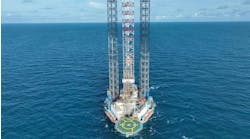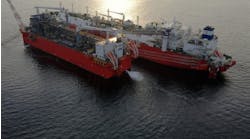Jeremy Beckman • London
Majors pinning hopes on mid-Norway
Mid-Norway's deepwater allure has not dimmed, despite a succession of dry holes in recent seasons. The sequence was only broken last summer, when Statoil found hydrocarbons in the Ellida structure. Although hardly an Ormen Lange look-alike, it was enough to revive interest in the Norwegian Sea in Norway's 18th licensing round, the results of which were announced in June. All the majors that applied for deepwater acreage in this area gained operatorships, four going to Statoil, two to ChevronTexaco and Shell, and one each to ENI and Total.
Shell seems to have shrugged off the letdown of its last well in this sector on the highly rated President block. It is already looking for a seismic acquisition vessel for its new acreage. Statoil too plans seismic on its blocks this season, possibly followed by a well next year.
Outside the Norwegian Sea, most interest focused on some of the less explored regions of the southern North Sea. Here ExxonMobil gained a strip of 11 blocks, while UK independent Paladin Resources and its Norwegian partners Pertra and Revus Energy secured acreage in the Egersund Basin, 100 km southwest of Stavanger. This includes the Yme oilfield, prematurely abandoned by Statoil in 2001. Paladin sees scope for a redevelopment using more advanced production well techniques. An analyst's report suggested a further 40 MMbbl could be recovered.
Other governments across northern Europe have been serenading the industry. Britain's DTI received 76 applications for new licenses under its 22nd offshore round, including 20 from companies new to the UK shelf. Four of the requests were for 'frontier' licenses in waters west of the Shetlands. Even farther west, the Faeroe Islands parliament has approved August 17 as the launch date for the second Faeroese offshore licensing round. On offer will be 118 full or part-blocks, including acreage close to block 6004/16 on the UK median line, where Amerada found oil with its probe on the Marjun structure in 2001. Licenses should be issued next January.
Ireland, which has had its share of deep-water exploration duds, is looking for a change of luck from its latest round in the northeastern part of the Rockall Basin. This time, the government plans a special pitch at some of the independents currently flocking to the UK and Norway. In The Netherlands, the government is reconsidering its contentious decision to abolish depreciation at will on Dutch sector assets.
Petro-Canada's giant step
Canada is strengthening its grip on Britain's offshore establishment. Petro-Canada looks set to become EnCana's senior partner on the Buzzard project, having agreed to pay $840 million for Intrepid's 30% stake. The transaction, which was expected to go through at the end of June, included adjoining exploration acreage. Petro-Canada agreed to take 90% of a new license 40 km northwest of Buzzard in the Outer Moray Firth. This was awarded to Reach Exploration last year under the UK's 21st Licensing Round. Reach has identified several high-potential leads from newly re-processed seismic. The partners are looking to start drilling next year.
According to analysts Wood Mackenzie, Petro-Canada had been under pressure to make such a move, following negative investor sentiment over its modest growth prospects. Its previous work on the UKCS focused on some small-scale holdings acquired from Veba, such as the Clapham and Pict field developments. Also on the rise is fellow Calgary stalwart CNR International, which recently snapped up Eni's remaining operated UK assets. Of these, Balmoral, Stirling, and Glamis were known to be on the market for some time. The sale of T-block fields, all produced through the Tiffany platform, came as more of a surprise.
Further down the ladder, but gaining elevation, is UK independent Venture Petroleum, which has provisionally agreed to unitization of the new platform-based Saturn development in the southern gas basin with operator Cono-coPhillips and its partners. One of the three fields in this project, Atlas, extends into acreage that Venture acquired from Conoco in 2001. The six-slot platform will export gas to Theddlethorpe in Lincolnshire through the Loggs pipeline network. Drilling will be phased, with production – likely to start late next year – building to a peak of 170 MMcf/d in 2006. Gross reserves are put at 240 bcf. Venture is also seeking approval to tie its Annabel discovery, just to the south, into its Audrey A platform in neighboring block 48/15a.
Norne expansion tabled
Statoil has submitted a $530-million plan to Norway's authorities covering its long-awaited Norne satellites development. Staer and Svale, two small discoveries in the Norwegian Sea, will be linked to the Norne FPSO through eight subsea wells. The trees and templates will be supplied by FMC Kongsberg and Aker Marine Contractors. Combined production should add 70,000 b/d through the Norne facilities. Linerle, a recent discovery northeast of Norne, has been kept out of the equation for the time being. Statoil plans further evaluation of this and the nearby Falk structure, both of which contain heavier crude.
In the North Sea, Norsk Hydro has proved up small quantities of oil at its Brage complex. The discovery came in Jurassic sandstones, at a deeper stratigraphic level than the field's main reserves. Since coming onstream in 1993, Brage's output has declined to around 40,000 b/d. ExxonMobil also announced a new find with its West Cable probe, drilled 35 km southwest of the Balder field by the Deepsea Delta. ExxonMobil is on the lookout for new reserves to extend the life of both the Balder and Ringhorne facilities.




